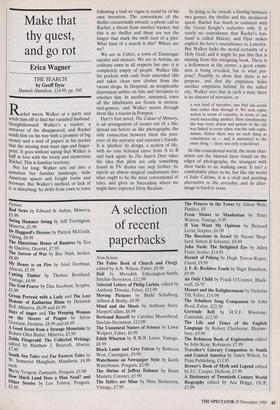Make that thy quest, and go rot
Erica Wagner
THE SEARCH by Geoff Dyer Hamish Hamilton, £14.99, pp. 160 Rachel meets Walker at a party and sends him off to find her vanished husband. Straightforward: Walker's a tracker, a retriever of the disappeared, and Rachel sends him on his way with a promise of big Money and a wad of papers in his pocket that the missing man must sign and finger- print. It goes without saying that Walker is half in love with the lovely and mysterious Rachel. This is familiar territory.
Not for long. Walker sets out into a nameless but familiar landscape, wide American spaces and freight trains and freeways. But Walker's method, or lack of it, is disturbing: he drifts from town to town following a trail so vague it could be of his own invention. The conventions of the thriller occasionally intrude: a phone call to Rachel, a threat from another tracker; but this is no thriller and these are not the hinges that mark the swift turn of a plot. What kind of a search is this? Where are we?
We are in Usfret, a town of Dantesque squalor and menace. We are in Avlona, an ordinary town in all respects but one: it is completely empty of people. Walker fills his pockets with cash from untended tills and takes clean new clothes from the vacant shops. In Despond, an inexplicable depression settles on him and threatens to smother him. In another, unnamed, town all the inhabitants are frozen in motion, mid-gesture, and Walker moves through them like a tourist in Pompeii.
Dyer's first novel, The Colour of Memory, is an arrangement of scenes out of a life, spread out before us like photographs, the only connection between them the pres- ence of the narrator and narrator's friends. It is 'plotless' by design, a section of life, with no easy fictional curve from A to B and back again. In The Search Dyer takes the idea that plots are only something found in TV drama one step further: he injects an almost magical randomness into what ought to be the most conventional of tales, and gives us Surrealism where we might have expected Dirty Realism.
In doing so he reveals a kinship between two genres: the thriller and the mediaeval quest; Rachel has much in common with the Green Knight's seductive wife. It is surely no coincidence that Rachel's hus- band is called Malory, and Dyer makes explicit his hero's resemblance to Lancelot. But Walker lacks the moral certainty of a Holy Grail, and it might be just this that is missing from this intriguing book. There is a hollowness at the centre: a great empti- ness is being revealed, but to what pur- pose? Possibly to show that there is no purpose, and that the emptiness hides another emptiness behind. In the stilled city, Walker sees that in such a state there is an absence of narrative, or a new kind of narrative, one that ran across time rather than through it. We seek expla- nation in terms of causality, in terms of one event succeeding another. Here simultaneity, the way every action and person in the city was linked to every other, was the only expla- nation. Either there was no such thing as coincidence or - and it amounted to the same thing - there was only coincidence.
In this coincidental world, the main char- acters are the blurred faces found on the edges of photographs, the strangers with their backs to us, walking away. It isn't a comfortable place to be, but like the world of Italo Calvino, it is a vivid and puzzling alternative to the everyday, and its after- image is hard to erase.










































































 Previous page
Previous page